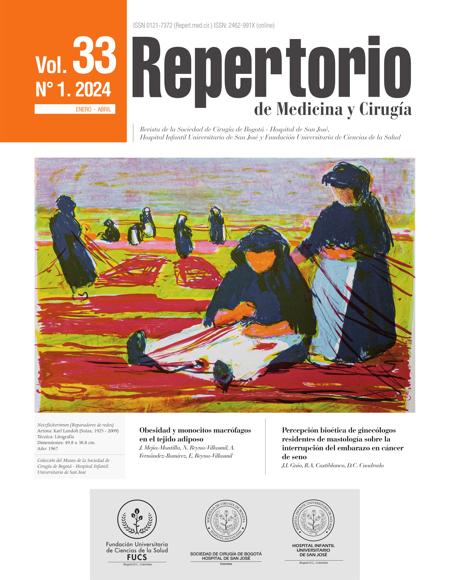Abdominal wall defects: omphalocele
Alteraciones de la pared abdominal: onfalocele
![]()
![]()

Show authors biography
Introduction: abdominal wall defects are congenital malformations associated with herniated abdominal organs, such as omphalocele. Its estimated prevalence is 1 per 10.000 live births in western countries. In Colombia the prevalence of omphalocele remains unknown. Omphalocele may be pre or postnatally diagnosed. A series of systemic clinical exams, secondary diagnostic evaluation and assessment for accompanying anomalies, are necessary. Treatment has improved survival rate to 70 and 95%. Objective: to increase awareness of this anomaly and correlate genetic, environmental and clinical findings and complementary exams to enable the early diagnosis and referral of these patients to receive optimal treatment which will reduce mortality. Materials and methods: updated literature review using Pubmed, UpToDate and ClinicalKey search engines, focused on systematic reviews, clinical cases and main international clinical practice guidelines. Found data was submitted to the head of the pediatric surgery department and to the publications division for their information, review and approval Results: 17 articles published in the last 5 years including the most relevant which contained current clinical evidence, were selected. Discussion and conclusions: recent studies have evidenced new findings that have improved survival and reduced mortality in the last 50 years.
Article visits 5029 | PDF visits 13014
Downloads
- Nathan Amy T. El ombligo. En: Kliegman RM, Blum NJ, Shah SS, et al. Editor. Nelson. Tratado de pediatría. Barcelona, España: Elsevier;2020. p. 975-976.
- Akinkuotu AC, Sheikh F, Olutoye OO, Lee TC, et al. Giant omphaloceles: surgical management and perinatal outcomes. J Surg Res. 2015;198(2):388-92. doi: 10.1016/j.jss.2015.03.060 DOI: https://doi.org/10.1016/j.jss.2015.03.060
- Jhon C, Hector R, Muñetones N, Navarro S. Manejo médico del onfalocele gigante con sulfadiazina de plata tópica. Repert Med Cir. 2015;24(1):64-68. https://doi.org/10.31260/RepertMedCir.v24.n1.2015.659 DOI: https://doi.org/10.31260/RepertMedCir.v24.n1.2015.659
- Copel JA, D'Alton ME, Feltovich H, Gratacós E. Obstetric Imaging:Fetal Diagnosis and Care,Omphalocele. 2ed. Philadelphia: Elsevier Inc. 2018.
- Capecchi GA, Conde A, Rovere L, Sasia F, Oxilia H, Capomasi M. Defectos congénitos de la pared abdominal. Patologías más comunes: Gastrosquisis y Onfalocele. Anuario fundación Dr. J. R. Villavicencio. 2008;XVI:45-50.
- Klein M. Congenital Defects of the Abdominal Wall. En: Coran A. et al. editor. Pediatric Surgery. 7ed. United States of America: Saunders, an imprint of Elsevier Inc; 2012. p. 973-984. DOI: https://doi.org/10.1016/B978-0-323-07255-7.00075-1
- Klein MD. Congenital Defects of the Abdominal Wall. En: Coran AG., Editor. Pediatric Surgery. Philadelphia: Elsevier; 2012. p. 973-984. DOI: https://doi.org/10.1016/B978-0-323-07255-7.00075-1
- Primucci P, Viglanco M, Brignoli V. Onfalocele. Rev Arg de Ultrasonido. 2009;8(1):5-8.
- Ledbetter DJ, Chabra S, Javid PJ. Abdominal wall defects. In: Gleason CA, Juul SE. Editor. Avery's Diseases of the Newborn. 10ed. Philadelphia: Elsevier; 2018. p. 1068-1078. DOI: https://doi.org/10.1016/B978-0-323-40139-5.00073-5
- Bedeschi MF, Calvello M, Paganini L, Pezzani L, Baccarin M, et al. Sequence variants identification at the KCNQ1OT1:TSS differentially Methylated region in isolated omphalocele cases. BMC Med Genet. 2017;18(1):115. doi: 10.1186/s12881-017-0470-z. DOI: https://doi.org/10.1186/s12881-017-0470-z
- Díaz C, Copado Y, Muñóz G, Muñóz H. Malformaciones de la pared abdominal. Rev Med Clin Condes. 2016;27(4):499- 588. https://doi.org/10.1016/j.rmclc.2016.07.009 DOI: https://doi.org/10.1016/j.rmclc.2016.07.009
- Hassan M. OEIS complex with a vesico-enteric fistula RSS. J Pediatr Surg Case Rep. 2018;(35):45-47. https://doi.org/10.1016/j.epsc.2018.05.016 DOI: https://doi.org/10.1016/j.epsc.2018.05.016
- Del Río Romero L, Blanco Figueredo N, Rodríguez Domínguez Z. Diagnóstico prenatal de onfalocele mediante ultrasonografía. Rev Cubana Obstet Ginecol. 2014;40(2):265-271.
- Cuervo JL. Defectos de la pared abdominal. Rev. Hosp. Niños (B.Aires) 2015;57(258):170-190
- Bass LM, Wershil BK. Anatomy, Histology, Embryology, and Developmental Anomalies of the Small and Large Intestine. En:Feldman M, Friedman LS, Brandt LJ. Editor. Philadelphia: Elsevier;2015. p. 1551-1579.e3.
- Valdés O MV, Morán V J. Onfalocele y Gastrosquisis. 2017. p.3.












